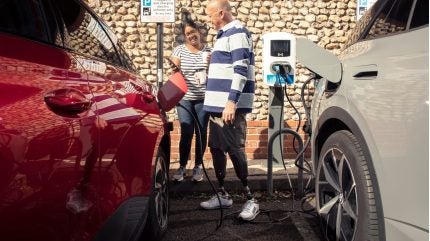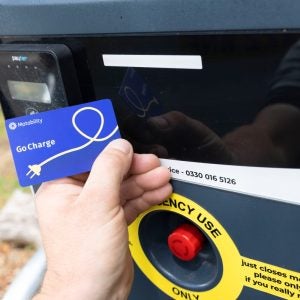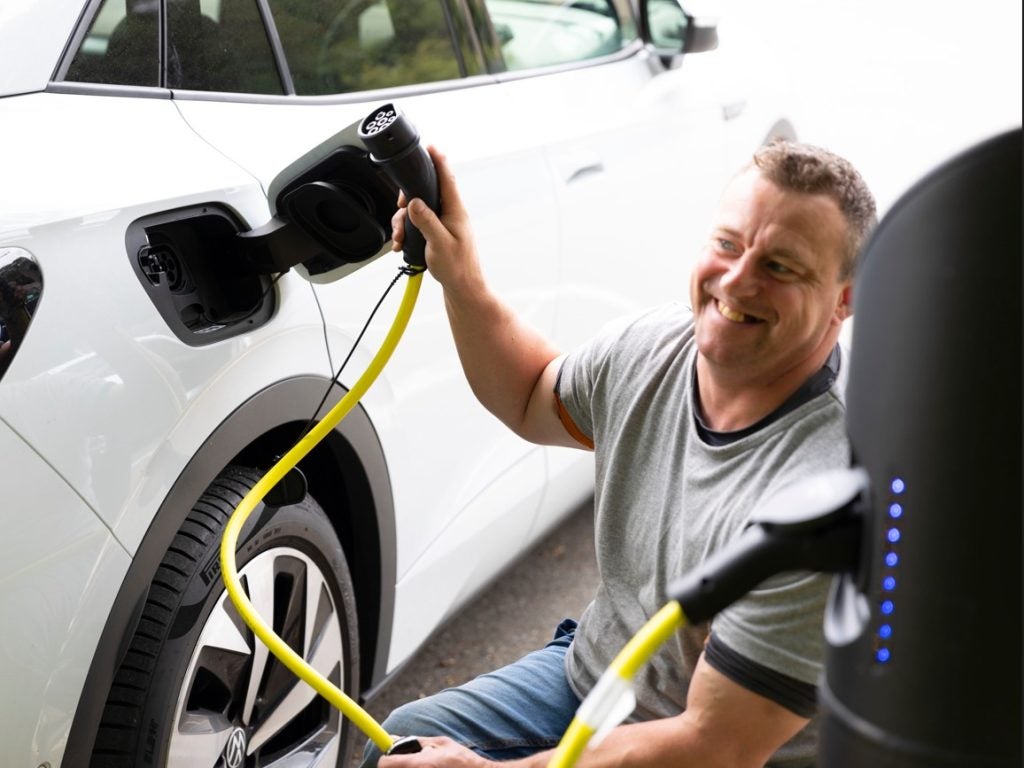
One in five people in the UK live with a disability. It is predicted that the number of disabled disabled drivers, or passengers, in Britain could rise to 2.7 million by 2035. Alongside government regulations for the ending the sales of new ICE-only vehicles by 2035, these drivers will increasingly transition to EVs.
However, disabled EV drivers face a number of additional challenges such as non-accessible charge points, difficulty in making payments, the inability to add ramps to vehicles and more.

Discover B2B Marketing That Performs
Combine business intelligence and editorial excellence to reach engaged professionals across 36 leading media platforms.
To assist with these pain-points, Motability Operations, the company that runs the life-changing Motability Scheme in the UK, has launched ‘Go Charge’, billed as a solution to simplify public EV charging for its customers. Partnering with tech company, Paua, ‘Go Charge’ provides a free app and card that streamlines the process of finding and paying for EV charging. It covers more than 70% of all rapid charge points across the UK.
We spoke to head of innovation, Motability Operations, Jon Jenkins, to hear more about the assistance offered to disabled EV drivers, and the challenges they face.

Just Auto (JA): Could you provide some background on the company?
Jon Jenkins (JJ): We are the company behind the Motability Scheme, which provides vehicles to 760,000 disabled people across the UK. We deliver smart, sustainable solutions that ultimately improve our customers’ mobility.
To be eligible for the scheme you need to be a recipient of a higher or enhanced mobility allowance. Should you be a recipient then you’re entitled to come on to the scheme and we provide a fully wrap-around package.
In exchange for your benefit, we can provide you with a vehicle that will come with breakdown cover and insurance; all you need to do is put fuel in.
We’ve been going since the 1970s, but really have arrived at scale over the last 15 years or so. In the last few years, we’ve grown rapidly. I think our offering is very competitive; we put our customers first and they’re at the heart of everything we do.
What benefits do EVs provide for disabled drivers?
An EV can be a more beneficial vehicle [than a conventional car] for our customers. It can mean having a vehicle that you haven’t got to scrape the ice off, that you get into and the steering wheel is warm (which is great because you might have dexterity problems with your hands). A lot of the doors on a lot of vehicles now open with touches of buttons.
There’s also the fact that you can drive EVs using a single pedal because you’ve got the regenerative braking – that is also a plus. I think there are a lot of benefits once we have resolved early issues surrounding the charging process itself and range anxiety.
It does sometimes become hard to see those benefits, but for me it can be a better vehicle for our customers’ needs. We just have to get through some of the growing pains that we’re experiencing at the moment. We need to get over those before I think you can really take advantage of some of the benefits of the vehicle.
Could you describe the ‘Go Charge’ app and its benefits?
We identified early on the pain for charging an EV was quite a big issue for our customers, and there’s lots of apps to download, which can be a complicated process.
We’re also finding that some of our customers do tend to take longer to manage the charge point process and connect the charger. EV chargers have a timeout functionality on them and some of our customers have been impacted by that time-out functionality – which can mean being hit by multiple pre-authorisation fees.
We identified early on the pain for charging an EV was quite a big issue for our customer
As an innovation team, we looked at what products are available on the market. A lot of it was fleet-focused rather than for individual consumers. We worked with a company called Paua and were able to work with them to develop a card that has zero authorisations, no subscription fee, just one app download, and you can use it on 70% of the UK charge stations network. Generally, all the big players are going to be on there.
You tap the card and go. It is backed up with your own credit card in the app. You put your payment details in, and then for every charge point you want to use, you can use the card to tap.

Within the app you can see all the locations that you want to charge at, which again was quite a big pain-point for our customers. I think many people are now so engrossed in EVs and the EV ecosystem that they almost forget those people that haven’t been part of the EV world; so it’s also about making people aware of issues.
Even just going back to the basics of ‘here are the chargers, these are the speeds, these are the costs, this is – physically – how you charge’ and so on. Providing that basic education we found alleviated some of the anxiety that our customers were having when it came to charging on the network.
We’ve successfully scaled it up and we’ve got 20,000 users; there are 7,000 very active users – that’s people using it on at least a monthly basis. But obviously there are going to be a lot of people that predominantly charge at home and therefore don’t need to use public charging very often.
I think one of the things we also recognise is we would typically over index on those people that can’t charge at home and creating solutions that work away from home is crucial to our customer base.
What are some of the particular challenges that disabled EV drivers face at the moment?
The majority of the challenges will centre around charging. However, if you look at our WAV (wheelchair accessible vehicle) fleet at the moment, it’s really hard to customise an electric WAV fleet because where we would normally put a ramp, there’s a big battery in place.
The majority of the challenges will centre around charging.
Also, the infrastructure now does not work for everyone. I think different charge points will have different accessibility downsides. Some will be more accessible than others, but likewise, some will be more accessible for some individuals than for others.
The operational issues for accessibilty vary. For example, the charger may be sitting on a curb, or there is gravel, or an uneven surface or the screen height is too high for the user to comfortably see. There may be bollards in the front of the car park, or the bay is rather narrow, or the cables for charger are not supported.
From that long list of potential difficulties, one of them might be highly relevant to one particular individual and one might be more relevant to another individual. Everyone is different and that applies to our users.
They’re not accessible for all. For example, if I’m a wheelchair user, I’ll probably be more concerned with whether the floor is a hard and even surface, and whether it’s got bollards or if it’s on a curb – because the rest of the things I might be relatively comfortable with.
There are lots of things that can mean an EV charger is not fully accessible for absolutely everyone.
The key thing though, is making sure that you can share with people what the accessibility information around that particular charge point is. We’ve already tested this with customers and if you give people the right information, it does alleviate a significant amount of the anxiety associated with charging.
I’d be interested to know whether any EV driver has never had range anxiety, because I think it’s something that everybody has experienced. When you first drive an EV you will have some level of range anxiety. What is different for different people is how long that range anxiety sits with you for, and how much of a burden it becomes in your day-to-day driving experience.
Range anxiety is exacerbated when it’s not just about finding a charge point, it’s about finding a charge point that can work for you. You add in a whole other layer of what leads to that range anxiety so you’re no longer simply thinking: can I find a charge point? You’re thinking: can I find a charge point that will work for me?
The key for us is how can we start giving our customers more enhanced information. I do believe the infrastructure will become more accessible for everyone but I don’t know how long it’ll take to get there.
Between now and then we’ve the small matter of 760,000 customers that we need to transition to electric. Those people all need to have the right level of information about the charging infrastructure in order for them to understand whether it can work for them or not. That’s really what we’re trying to achieve, and ‘Go Charge’ is the first big step in that direction.
Why do you think some charge points are not as accessible as they could be?
There’s a whole host of reasons. You might interview 15 people in the space and 13 of them will blame the CPOs (charge point operators), two of them will blame the landlord. There’s a whole host of reasons out there.
I don’t really want to get into who I’d blame, but I know it’s rather complex. A host of factors come into play. There’s acquiring the land, setting up the charge points, the ongoing rent that has to be paid, returns on investment and so on.
I also do not feel there’s been sufficient guidance on what an accessible charge point needs to be. To address this, the Motability Foundation, launched the PAS:1899 standards with BSI last year. They have launched standards to help charge point operators fit accessible charge points from the beginning. They’re a kind of gold standard of what an excellent accessible charge point should look like.
A lot of the charge point providers are working hard to bring their charge points up to standard, but that is a process in itself and that will take time.
Not every charge point is based on a lovely ten acre site where operators can map out exactly what they want to do. There are some cases where they need to put three chargers in those three spaces in town which haven’t got a drop curb, for example.
I think we’re constantly going to be challenged. However, what we are seeing is the CPOs that are able to design their own infrastructure on their own sites, taking notice of new standards. They are now saying: “Hang on a minute, not only is there a standard here, there’s also a huge fleet that’s going to transition very quickly. That’s going to be some of my bread and butter income and I actually need to build around them and their needs.”
Osprey are a good example of a CPO keen to partner with us and understand what our customers are feeling, facing, experiencing, but they’re also quite pragmatic in the fact that not every one of their sites is going to be able to meet all of these different standards immediately. It’s a process, but we are making progress on that journey to help our customers with the transition to EVs.





